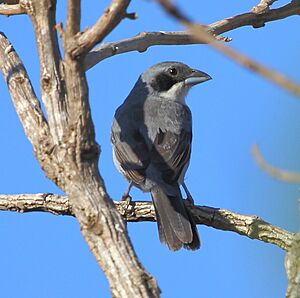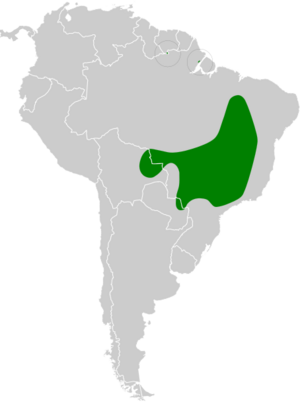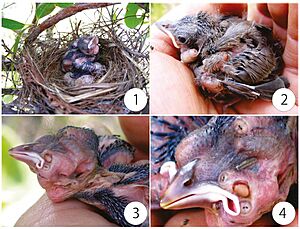Shrike-like tanager facts for kids
Quick facts for kids Shrike-like tanager |
|
|---|---|
 |
|
| at Alto Paraíso de Goiás, Goiás state, Brazil | |
| Conservation status | |
| Scientific classification | |
| Genus: |
Neothraupis
|
| Species: |
fasciata
|
 |
|
The shrike-like tanager (Neothraupis fasciata) is a cool bird from South America. It's also called the white-banded tanager. This bird belongs to the tanager family. It's special because it's the only bird in its group, called the genus Neothraupis.
About Its Name
Scientists give every living thing a special two-part name. This helps everyone know exactly which animal they are talking about. The shrike-like tanager got its first scientific name, Tanagra fasciata, in 1823. A German scientist named Hinrich Lichtenstein gave it this name.
Later, in 1936, an Austrian bird expert named Carl Eduard Hellmayr created the group Neothraupis just for this bird. The name Neothraupis means "new small bird." The second part of its name, fasciata, comes from a Latin word meaning "banded." This bird is the only species in its genus, which means it's unique!
What It Looks Like
The shrike-like tanager looks a lot like some other birds called shrikes. But don't be fooled! They are not closely related at all. Both male and female shrike-like tanagers look the same.
This bird is about 16 centimeters (about 6.3 inches) long. It weighs around 29 to 32 grams. That's about as much as a few pieces of candy!
Where It Lives
This bird lives in the middle of south-central South America. You can find it in places that are 550 to 1100 meters (about 1800 to 3600 feet) above sea level. It prefers a special type of woodland and shrubland called Cerrado.
You can mostly find it in central-eastern Brazil. It also lives in northeastern Paraguay and northeastern Bolivia. A good place to spot them is in Chapada dos Guimarães, Mato Grosso, Brazil.
How It Behaves and Reproduces
Shrike-like tanagers are often seen in pairs. They also hang out in small groups. These groups usually have about 7 birds, but can have up to 12. They like to eat insects.
They build their nests and lay eggs in October and November. Their nest is shaped like a deep cup and is lined with soft grasses. They usually build it in a small tree or bush. A female shrike-like tanager lays 2 or 3 eggs.
Sometimes, young birds from earlier broods help their parents raise the new babies. These helper birds have brownish feathers where adults have grey.



